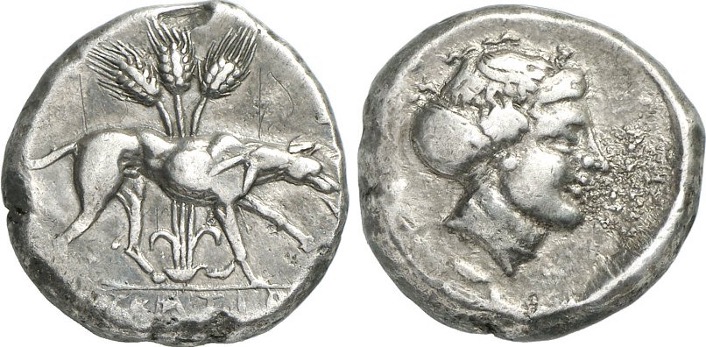420 BCE - 416 BCEEPYKAZIIB
Overstriking coin
SO_135_-_Eryx_(didrachm).jpg
|
|
Sale(s)Sale(s) ᵖ:
|
Gorny & Mosch, 215, 13 Oct. 2013, 681 = Peus, 413, 29 Oct. 2014, 17
|
|
|
|
Description
| ObverseInscription or printing placed on the obverse.:
|
EPYKAZIIB (Greek) Hound right. In the background, three grain ears.
|
ReverseInscription or printing placed on the reverse.:
|
Head of nymph right.
|
Mint and issuing power
| MintIdentifies the place of manufacture or issue of a numismatic object.:
|
Eryx
|
Ancient regionAncient region.
|
Sicily
|
Modern countryModern country: Italy
|
AuthorityIdentifies the issuing power. The authority can be "pretended" when the name or the portrait of X is on the coin but he/she was not the issuing power. It can also be "uncertain" when there is no mention of X on the coin but he/she was the issuing power according to the historical sources:
|
|
Chronology
| FromIdentifies the initial date in a range assigned in a numismatic context. 420 BCE toIdentifies the final date in a range assigned in a numismatic context.. 416 BCE
|
Classical 480-323 BC  periodTime period of the numismatic object. periodTime period of the numismatic object.
|
Physical description
MetalThe physical material (usually metal) from which an object is made.: Silver 
|
WeightWeight of the numismatic object (in grams). in grams: 8.728.72 g <br />8,720 mg <br />
|
DenominationTerm indicating the value of a numismatic object. Examples: tetradrachm, chalkous, denarius.: didrachm 
|
|
|
|
|
References
Description
| ObverseInscription or printing placed on the obverse.:
|
|
ReverseInscription or printing placed on the reverse.:
|
|
Mint and issuing power
| MintIdentifies the place of manufacture or issue of a numismatic object. ᵖ:
|
|
Ancient regionAncient region. ᵖ
|
|
Modern countryModern country:
|
AuthorityIdentifies the authority in whose name (explicitly or implicitly) a numismatic object was issued. ᵖ:
|
|
Chronology
| FromIdentifies the initial date in a range assigned in a numismatic context. toIdentifies the final date in a range assigned in a numismatic context..
|
periodTime period of the numismatic object.
|
Physical description
References
References
- ^ SNG ANS 3 Sicily
- ^ Hoover, Oliver D. (2012), The Handbook of Greek Coinage Series. 2. Handbook of the Coins of Sicily (Including Lipara). Civic, Royal, Siculo-Punic, and Romano-Sicilian Issues. Sixth to First Centuries BC, Lancaster-London, 489 p.
